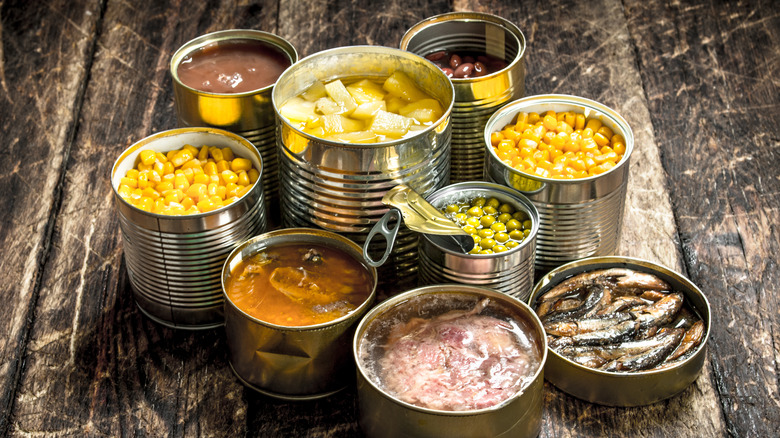The Meat Controversy That Nearly Ended Canned Food Forever
Keeping a pantry well stocked with canned foods might seem like a no-brainer of the modern world, it's a fairly recent invention in the history of humanity. Beyond that, it's one that might not have lasted too long thanks to an early controversy that nearly scared consumers away for good. As the BBC reports, the first canned foods began to appear at the very beginning of the nineteenth century. It became instantly popular with military forces like the British navy, and soon thousands of pounds of meat were being canned to fuel the growing empire.
This growing industry was then struck by controversy in 1852 when more than 1,500 tons of canned foods were discarded by food inspectors. They had received multiple reports that the supplier Stephen Goldner had been using meats other than those his products advertised in the cans. Goldner was a big name in the industry who had secured the contract to supply navy, but as demand increased his production facilities in Romania were clearly taxed and started cutting corners. Inspectors discovered hundreds of cans of food that contained rotting, putrid meat including tongues, livers, and offal that allegedly caused the inspectors to gag from the smell.
This went well beyond the military though, and threatened the greater public's perception of canned food.
The long term impact
The greater British public, and even those living outside of the empire in the young United States and continental Europe, were shocked by the revelation that such deceptive and dangerous tactics were employed in the canned food industry.
Even ten years after this revelation, the doctor and writer Andrew Wynter wrote about the public's prejudice against canned foods. He mentioned that this prejudice was also unfounded at the time, but perceptions had clearly been shaken and the canned food industry was deeply affected.
These fears died with time though, and nearly 30 years later, millions of pounds of canned meats would be imported into the U.K.. During that same time period the industry also grew and mechanized means of canning food were created. This development, along with an acceptance of canned evaporated milk, helped to shift perceptions back into vogue and save the young industry from scandal. It probably helped that Louis Pasteur also made his groundbreaking discoveries of just why canning food was safe and effective in 1861.
The state of canned foods today
While we think of canning food as a modern home convenience, its peak use was always during times of war. Not only did tinned food help feed the front lines during the two World Wars, but canning at home soared during these periods as well as a means of stretching food and rations.
The New York Times reports that canned food also saw another massive spike in recent years thanks to the pandemic. As most of the population became shut-ins almost overnight, foods that could keep for weeks or months started flying off the shelves.
This has also helped to fuel the popularization of tinned fish as a culinary trend. Chic New York City restaurants even include high quality tins of sardines and anchovies on their menus. This shows that not only has canned food survived its earliest scandals, but its moved beyond its utilitarian roots into the realm of luxury as well.


